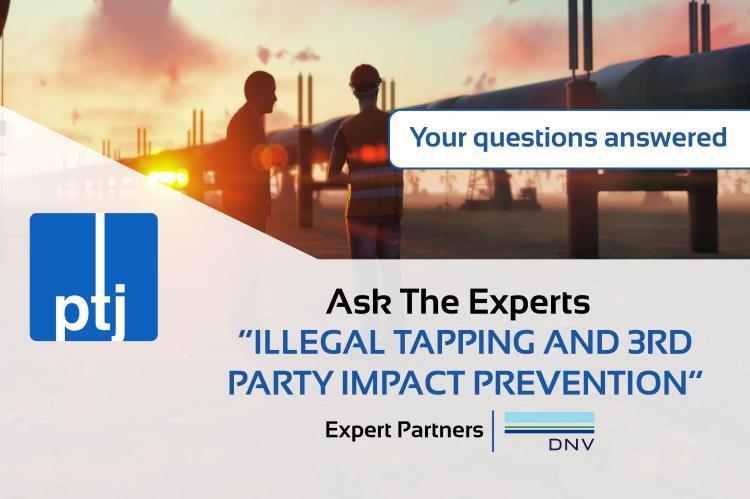[Ask the Experts] Your Questions about Illegal Tapping and 3rd Party Impact answered

Q1) Do you think satellite-based monitoring of 3rd party impacts will replace traditional monitoring methods such as helicopter-based monitoring?
Victoria Monsma: Despite its many advantages, satellite-based monitoring has some way to go before it can completely replace traditional monitoring methods. For one, satellite monitoring is greatly impacted by weather just as other standard radar-based systems. The detection time depends on the frequency of the monitoring. The advantage of satellite inspections is that relatively large areas can be monitored. However, it is unlikely that small leaks will be detected with this. A satellite has a slow response and long data processing time. In the future, it is expected that major savings will be achieved by replacing conventional techniques with remote surveillance techniques, using advanced image processing. This requires improving response times and greater accuracy compared to the current situation.
Q2) Should the theft detection and leak detection systems be one system or is it better to use separate systems based on different principles?
David Stobb: A comprehensive loss detection program should incorporate multiple detection and monitoring approaches. Each type of detection system has its strengths and weaknesses, so multiple systems can complement each other and provide better overall monitoring of the system.
Victoria Monsma: Combining two or more leak detection systems may also provide more confidence in the overall leakage detection system. Complementary detection technologies should be selected to compensate for the weaknesses from one system to be confirmed by positive indications from the other.
Q3) How can we design our new pipelines to have a more efficient leak detection system?
David Stobb: Pipeline design can anticipate the needs of a leak detection system in a number of ways. For a leak detection system that utilizes typical instrumentation, that instrumentation which includes flow, pressure, temperature, and fluid property measurements can be placed in locations along the pipeline that benefits the leak detection technology. It is also not just related to the physical design of the pipeline but to how the pipeline is designed to operate. For liquid pipelines, the control system designed to avoid surge events and/or any slack or cavitation events reduces complexity in the system that must be monitored.
Typically, proven leak detection technologies can provide some degree of leak performance or sensitivity analysis at the design phase of a new pipeline that results in a final system that is better suited to meet the operator’s leak detection goals.
Victoria Monsma: For designing an appropriate leak detection system, clear performance requirements for the system should be developed. The requirements should be based on various aspects, including:
• authority requirements
• corporate requirements
• specific conditions that could affect the performance of the detection system
• interface to the control system
• safety philosophy
• integration into the overall operational management philosophy
A leak detection system includes selected leak detection technologies as well as tools for data management, operational procedures, and the layout/placement of sensors. The total system layout should fulfill the developed specific performance requirements.
Q4) What technical considerations should be considered when selecting a leak detection and/or intrusion detection system?
David Stobb: Technical considerations for leak detection systems should include system performance, ongoing and future maintenance needs, and additional benefits outside of leak detection. For performance, the system should be reliable, robust, and accurate at detecting small losses without false indications under all pipeline operating conditions. Future maintenance needs should be considered as any system will need to be updated and maintained as the pipeline system changes over time. Also, the corresponding effort and cost associated with keeping the leak detection system operating optimally must be considered.
Finally, many leak detection systems can offer additional benefits for pipeline operation, such as improved understanding of the hydraulic operation of the pipelines, enhanced understanding of the surrounding environmental conditions, or as a starting point to enhancing or optimizing operational performance.
Victoria Monsma: There are many different leak detection systems available. When selecting a leak detection system, some important technical points should be considered: the system should be fast, reliable, accurate, affordable, and robust and could be used in combination with other techniques such as inspection by foot, car, helicopter, drone, or satellite. One of the most important requirements when designing a leak detection system is detection time, which is based on the safety philosophy. Furthermore, the leak detection system should be based on proven technologies.
Got more questions about Illegal Tapping and 3rd Party Impact Prevention for Pipelines? Want to speak to an expert at DNV or know more about our solutions? Submit your queries here or write to us at digital@dnv.com
The Experts
David Stobb, Principal Pipeline Engineer, DNV
David Stobb has been with DNV for over 26 years and for most of that time has been involved with the deployment of real-time transient model-based leak detection systems for transmission pipelines. In addition to leak detection systems implementations, he provides technical oversight to a team of engineers and consultants as they deliver various solutions involving transient hydraulic models.
Victoria Monsma, Senior Pipeline Integrity Specialist, DNV
Victoria provides technical advisory on different pipeline integrity and safety issues. Recently, she has been actively involved in hydrogen conversion studies and initiatives for many international clients. Victoria is a member of a working group of Dutch standards for pipelines NEN 3650/3651- Requirements for pipeline systems.
